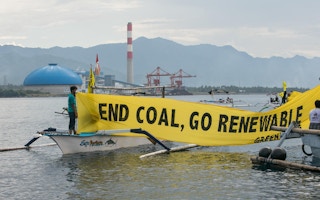Away from the frenetic tourism development that has taken over the beaches of southern Bali, the Indonesian resort island’s northern coast remains largely rural and agrarian. Per capita income here is lower than in the south, and authorities hoped for an economic revival with the construction of a coal-fired power plant, underwritten by Chinese loans.
But the Celukan Bawang plant, completed in 2015, has instead been blamed by environmental advocacy group Greenpeace for polluting the local environment and depriving residents of their livelihoods. This is in addition to long-running disputes over the 40 hectares (99 acres) of land on which it sits.
In a report published in April, Greenpeace quoted a number of residents and local officials it had interviewed in May 2017 and who were opposed to the power plant. It concluded that the plant was “destroying local livelihoods and threatening the health of nearby communities,” and that the interviews “revealed problems over land and compensation, the impact on the local economy, environmental degradation and health impacts caused by the power plant.”
The 426-megawatt plant was built by a Chinese-Indonesian consortium that included China Huadian Engineering Co. Ltd, Merryline International Plt. and PT General Energy Bali, and received funding of $700 million in the form of loans from state-owned China Development Bank. It reportedly burns through 5,200 tons of coal a day, and can meet two-fifths of Bali’s power demand, according to Jian Fang Shuai, a director at Huadian.
From the outset, however, the project has been opposed by residents concerned about pollution, waste, their livelihoods, and unresolved land compensation deals. A third of the plant’s site remains under dispute, according to Greenpeace.
Ketut Mangku Wijana, a 56-year-old resident, was one of those interviewed who told Greenpeace he would not give up his land. He told the group that he did not sell his land to the plant operator because they could not agree on a fair price.
“They have not been transparent since the very beginning and they also used a middle man to buy my land on the cheap,” he said.
If the community had known the land would be used for a power plant, he added, “most of them would probably not have sold their land.”
Karimun, 63, lives just 50 meters (164 feet) from where the plant’s smoke stacks stand today, with nine other family members. She complained of dust, fumes and liquid waste that she said she saw being dumped near her home.
“I’m worried about my health,” she said in the report. “I’ve gotten sick, so have my grandchildren, usually from respiratory issues and fevers. But what can I say. The price is not right, so I don’t want to move.”
The villagers interviewed by Greenpeace also said the power plant affected the local economy for the worse. Fishing is one of the main sources of livelihood in the area, but local fishermen are having to go further out to sea because catches closer to shore have declined.
Eko, a member of a fishing cooperative in Celukan Bawang village, blamed coal freighters for damaging the coral reefs and driving fish away. The power plant has also necessitated the building of a dock for the ships, which Mulyadi, a district councilman, said had destroyed the coastal ecosystem.
Also at issue is the plant operator’s promise to hire local residents. Agus Adnan, the Celukan Bawang village council head, said the number of positions being offered was too low.
“The number of local residents hired to work at the plant does not compare with the level of grief they endured,” he said in the report.
Nearly everyone quoted in the report complained of health problems. Emissions from coal-fired power plants can expose people living within the vicinity of such facilities to dangerous levels of microscopic particles known as PM2.5. Long-term exposure to such particulates can cause acute respiratory infections and cardiovascular disease. Other noxious emissions produced by coal-fired power plants include nitrogen dioxide and sulfur dioxide, and heavy metals like mercury.
“Governments at all levels continue to ignore these impacts. The surrounding community is left alone to deal with the problems,” Greenpeace said in a statement on April 16.
“
It’s not about whether or not we believe [the Greenpeace report]. But we have to look at the report in detail: Who’s being poisoned? Where’s the proof?
I Made Gelgel, chief, environmental agency, Buleleng district
It has called on the district, provincial and national governments to monitor air quality and conduct periodic medical checks on the community living around the power plant; to monitor the environmental degradation caused by the plant and scrap a planned expansion; and to develop a national energy plan based on sustainable, renewable energy.
Local officials, however, are skeptical. The environmental agency in Buleleng district, where the plant is located, told Mongabay-Indonesia that its own tests showed that water and air quality near the power plant were at acceptable levels.
It said the pH of the seawater near the plant was 8.37, below the upper limit of 8.5. Meanwhile, six samples of seawater gave an average water temperature of 30.9 degrees Celsius (87.6 degrees Fahrenheit), lower than the limit of 35 degrees Celsius (85 degrees Fahrenheit).
The agency also said it had examined the plant’s waste facility and concluded it was in line with official requirements. It has ordered the plant operator to submit an environmental report to the agency every six months, according to environmental agency chief I Made Gelgel.
“It’s not about whether or not we believe [the Greenpeace report],” Gelgel said. “But we have to look at the report in detail: Who’s being poisoned? Where’s the proof?”
This story was published by Mongabay.com. Read the full story.










